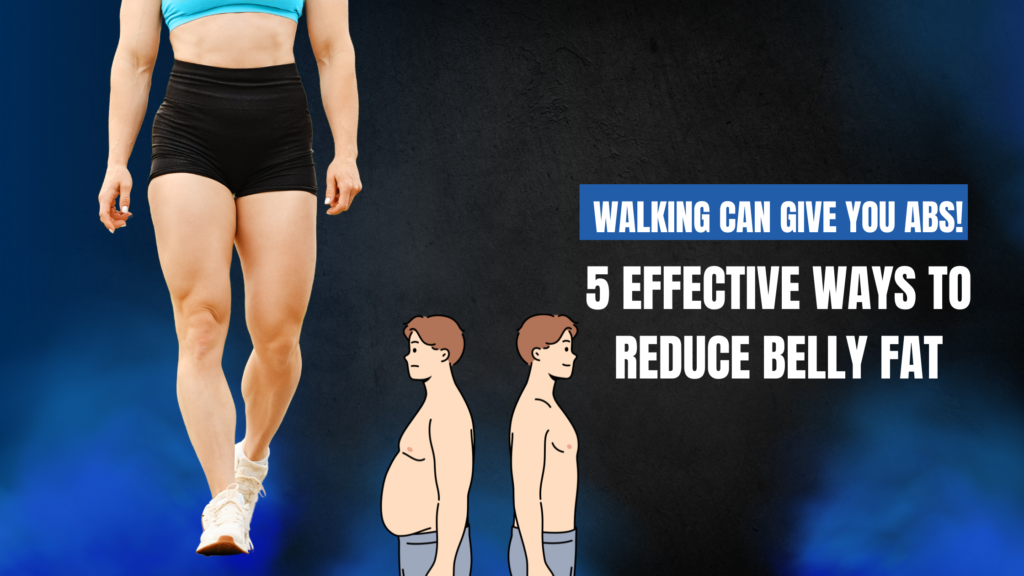Walking is often underestimated as an exercise for sculpting abs. Many people associate it primarily with improving cardiovascular health or toning the legs, but walking can be an effective full-body workout that engages your core muscles and helps you reduce belly fat. While crunches and sit-ups are traditional exercises for building abs, walking, when done correctly, can also strengthen your abdominal muscles. The key lies in engaging your core and maintaining the right posture as you walk.
Here, we’ll explore how walking can help you achieve abs and five effective strategies to maximize the impact of your walking workout.
How Can Walking Help You To Reduce Belly Fat And Get Abs?
Walking isn’t just about moving your legs—your entire body is involved in this simple yet effective exercise. Every step you take engages multiple muscle groups, including your core muscles, which play a crucial role in stabilizing your body, maintaining balance, and preventing your torso from swaying. This constant engagement helps to strengthen and tone your abdominal muscles, such as the rectus abdominis (your six-pack muscles) and the obliques (muscles on the sides of your abdomen).
Moreover, research published in the Psychology of Sport and Exercise suggests that walking on uneven surfaces or incorporating hill climbs into your routine can provide an even greater challenge for your core. The uneven terrain requires more balance and stability, engaging your abs further.
But how exactly can you turn your daily walk into an effective ab workout? Here are five proven strategies to help you tone your abs while walking.
5 Easy Ways to Tone Abs While Walking
1. Engage Your Core Muscles
To tone your abs while walking, the most straightforward method is to consciously engage your core muscles. Think of pulling your belly button towards your spine and tightening your abdominal muscles. This technique stabilizes your torso, improves your posture, and activates the muscles in your midsection. Maintaining this engagement throughout your walk forces your core to work continuously, which can lead to stronger, more defined abs over time.
A study from the Journal of Applied Physiology has shown that engaging core muscles during low-intensity exercises like walking can significantly increase muscle activation in the rectus abdominis. This constant tension not only helps in toning but also in building endurance in your core.
2. Add Interval Training
Interval training is an effective way to ramp up the intensity of your walking routine and target your core muscles. By alternating between periods of brisk walking and slower paces, or by incorporating short bursts of jogging or speed walking, you force your core to work harder to maintain stability and balance. This additional effort can help tone your abs faster.
For example, try a simple routine where you walk briskly for two minutes, then slow down for one minute, and repeat this cycle throughout your workout. According to a study in the Journal of Obesity, interval training can lead to significant reductions in abdominal fat, even more so than steady-state cardio, because the varying intensities challenge your body to adapt and burn more calories.
3. Incorporate Arm Movements
Using your arms while walking can further engage your core muscles. When you swing your arms with each step, keeping them bent at a 90-degree angle, your core has to stabilize your body against the natural momentum of your arm movements. This can lead to a more effective ab workout.
To take it a step further, try holding small hand weights or performing simple arm exercises like bicep curls or overhead presses as you walk. A study from the American Council on Exercise found that combining upper-body movements with walking not only increases calorie burn but also engages the core more intensely to maintain balance.
4. Walk on Uneven Surfaces or Hills
Walking on uneven terrain or uphill can significantly increase core engagement. When you walk on surfaces like trails, beaches, or hillsides, your body has to work harder to maintain balance and stability, which in turn requires greater activation of your abdominal muscles.
Hill climbs are particularly effective because they require you to lean slightly forward, engaging your core muscles even more to keep your body steady. According to a study in the Journal of Sports Science & Medicine, uphill walking activates the lower abs and obliques to a greater extent than walking on a flat surface. This makes hill walking a powerful tool in your quest for toned abs.
5. Focus on Good Posture
Good posture is key to toning your abs while walking. When you stand tall with your shoulders back and down, head up, and chin parallel to the ground, your core muscles are naturally engaged to support this alignment. This helps strengthen and tone your abs over time while also preventing lower back pain.
Maintaining proper posture also makes your walking workout more efficient. Research in the European Journal of Applied Physiology has demonstrated that proper posture during walking can improve breathing, oxygen intake, and overall energy expenditure, making your workouts more productive and effective.
Tips to Maximize Results of Reduce Belly Fat While Walking
If you’re serious about getting abs through walking, here are a few additional tips to help you achieve the best results:
-
Increase Your Walking Time: The more you walk, the more calories you burn, and the more your body uses stored fat for energy. Aim for at least 30 minutes of brisk walking most days of the week.
-
Vary Your Routes: Mix up your walking routes to include a combination of flat, uphill, and uneven terrain. This variation will keep your core constantly challenged and help you avoid plateaus.
-
Wear Proper Footwear: Invest in a good pair of walking shoes that provide support and cushioning to prevent injuries and enhance your overall walking experience.
-
Stay Hydrated: Proper hydration is essential for optimal performance. Carry a water bottle with you, especially if you’re walking for extended periods or in hot weather.
-
Combine with a Healthy Diet: Walking alone won’t give you abs if your diet is not aligned with your fitness goals. Focus on a balanced diet rich in lean proteins, whole grains, healthy fats, and plenty of fruits and vegetables to support muscle growth and fat loss.
The Science Behind Walking and Reduce Belly Fat
Walking may seem like a gentle form of exercise, but its benefits extend far beyond just cardiovascular health. Walking helps to reduce belly fat by increasing your heart rate, which in turn burns calories. When combined with core engagement and proper posture, walking becomes a powerful tool for targeting belly fat.
Studies published in the American Journal of Clinical Nutrition have shown that moderate-intensity exercises like walking can be just as effective as high-intensity workouts for burning fat, especially when it comes to reducing visceral fat — the fat stored around your organs that is linked to various health risks.
Walking also promotes the release of endorphins, which can help reduce stress. Lower stress levels are crucial for managing cortisol, a hormone that, when elevated, is known to contribute to the accumulation of belly fat.
Conclusion: Start Walking Your Way to Reduce Belly Fat & Abs!
Walking is a versatile, low-impact exercise that can be a surprisingly effective way to build abs and reduce belly fat. By incorporating techniques like core engagement, interval training, arm movements, uphill walking, and maintaining good posture, you can turn your daily walks into a powerful workout that sculpts your midsection and boosts your overall health.
So, lace up your shoes, step outside, and start walking your way to stronger abs! Remember, consistency is key, and with a little dedication, you’ll start to see the results in no time.
Ready to start your journey to a fitter, leaner you? Share your walking routines and tips in the comments below!





